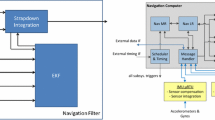Abstract
As NASA prepares to return humans to the Moon and establish a long-term presence on the surface, technologies must be developed to access previously unvisited terrain regardless of the condition. Among these technologies is a guidance, navigation, and control (GN&C) system capable of safely and precisely delivering a spacecraft, whether manned or robotic, to a predetermined landing area. This article presents a detailed study of both terrain-relative navigation using a terrain-scanning instrument and radiometric navigation using beacons in lunar orbit or on the surface of the Moon. The models for these sensors are developed along with a baseline sensor suite that includes an IMU, star-camera, altimeter, and velocimeter. Linear covariance analysis is used to rapidly perform the trade studies relevant to this problem and to provide the navigation performance data necessary to determine how each navigation method can be used to support a 100 m 3-σ navigation requirement on landing.
Similar content being viewed by others
References
GELLER, D.K. “Linear Covariance Techniques for Orbital Rendezvous Analysis and Autonomous On-board Mission Planning,” Journal of Guidance, Control, and Dynamics, Vol. 29, No. 6, 2006, pp. 1404–1414.
WOFFINDEN, D.C. and GELLER, D.K. “Relative Angles-Only Navigation and Pose Estimation for Autonomous Orbital Rendezvous,” Journal of Guidance, Control, and Dynamics, Vol. 30, No. 5, Sept–Oct 2007, pp. 1455–1469.
LEFFERTS, E.J., MARKLEY, F.L., and SHUSTER, M. “Kalman Filtering for Spacecraft Estimation,” Journal of Guidance, Control, and Dynamics, Vol. 5, No. 5, 1982, pp. 417–429.
PITTELKAU, M.E. “Rotation Vector in Attitude Estimation,” Journal of Guidance, Control, and Dynamics, Vol. 26, No. 6, 2003, pp. 855–860.
CRASSIDIS, J.L. and JUNKINS, J.L. Optimal Estimation of Dynamic Systems, ch. 5, CRC Press, 2004, pp. 243–329.
ELY, T.A. “Simplified Radiometric Measurement Models of the Lunar Network,” Unpublished.
SCHIESSER, E. “Navigation Error Covariance Matrices for CEV and LSAM lunar orbit GN&C Analysis,” personal notes, March 2006.
ELY, T.A. “Stable Constellations of Frozen Elliptical Inclined Lunar Orbits,” The Journal of the Astronautical Sciences, Vol. 53, No. 3, 2005, pp. 301–316.
ELY, T. A. “Constellations of Elliptical Inclined Lunar Orbits Providing Polar and Global Coverage,” The Journal of the Astronautical Sciences, Vol. 54, No. 1, 2006, pp. 53–67.
Author information
Authors and Affiliations
Additional information
Presented as paper AAS 009-057 at the AAS Guidance and Control Conference, Breckenridge, Colorado, January 30–February 4, 2009.
Rights and permissions
About this article
Cite this article
Christensen, D., Geller, D. Terrain-Relative and Beacon-Relative Navigation for Lunar Powered Descent and Landing. J of Astronaut Sci 58, 121–151 (2011). https://doi.org/10.1007/BF03321162
Published:
Issue Date:
DOI: https://doi.org/10.1007/BF03321162




